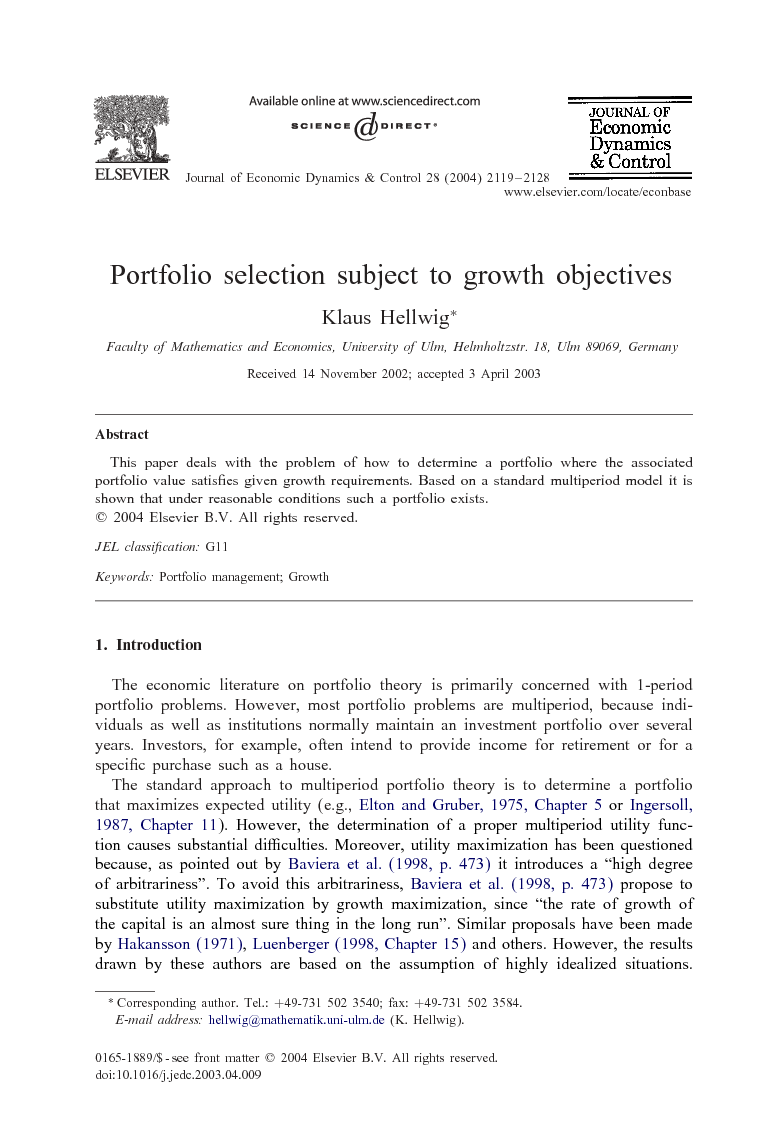The economic literature on portfolio theory is primarily concerned with 1-period portfolio problems. However, most portfolio problems are multiperiod, because individuals as well as institutions normally maintain an investment portfolio over several years. Investors, for example, often intend to provide income for retirement or for a specific purchase such as a house.
The standard approach to multiperiod portfolio theory is to determine a portfolio that maximizes expected utility (e.g., Elton and Gruber, 1975, Chapter 5 or Ingersoll, 1987, Chapter 11). However, the determination of a proper multiperiod utility function causes substantial difficulties. Moreover, utility maximization has been questioned because, as pointed out by Baviera et al. (1998, p. 473) it introduces a “high degree of arbitrariness”. To avoid this arbitrariness, Baviera et al. (1998, p. 473) propose to substitute utility maximization by growth maximization, since “the rate of growth of the capital is an almost sure thing in the long run”. Similar proposals have been made by Hakansson (1971), Luenberger (1998, Chapter 15) and others. However, the results drawn by these authors are based on the assumption of highly idealized situations. Luenberger (1998), for example, assumes that the investment environment is stationary in the sense that the same set of investment opportunities is available in every period and that the returns of these investments are independent and identically distributed between periods.
In addition, maximizing growth is not an appropriate objective if investors are not able or willing to renounce from consumption for a long time as is generally assumed in models of growth maximization. If savings are the only source of income, investors may even be forced to accept negative growth rates. To be of more practical interest, the approach therefore has to be generalized to account for more realistic situations where investors not necessarily want to maximize growth but have more general growth perspectives.
Such a generalization has been formulated by Hellwig 1987, Hellwig 1996, Hellwig 1998 and Hellwig 2002a, Hellwig et al. (2000), Korn 1997, Korn 1998 and Korn 2000, Korn and Schäl (1999) and Speckbacher (1998), who propose to determine a portfolio based on two conditions. (1) The portfolio should be intertemporal efficient or, equivalently, the portfolio should maximize the present value of consumption. (2) The discount rates should conform with growth preferences of the decision maker. That is, the discount rates are required to be chosen such that the time path of the present value of consumption satisfies the given growth requirements.
Condition (1) is self evident. Condition (2) is in accordance with the usual view that the discount rates should account for the preferences of the decision maker. However it can be shown (Hellwig et al., 2000, Hellwig, 2002b) that the approach is inconsistent with the traditional expected utility maximizing approach in the following sense. Suppose that a portfolio satisfying (1) and (2) exists. Then—because of the efficiency condition (1)—this portfolio in principle can be found by maximizing the expected value of some concave and componentwise increasing utility function. Now assume that the feasible set is changed. Using the same utility function then generally results in a portfolio where (1) and (2) are not met. This contradicts the traditional approach where it is assumed that a utility function exists that leads to the desired portfolio independent from the feasible set.
How to determine a portfolio that satisfies conditions (1) and (2) has been investigated by Hellwig (2002a). What remains is to provide economic meaningful conditions that guarantee the existence of such a portfolio. The aim of this paper is to fill this gap.
In Section 2 the portfolio problem is formulated as a standard multiperiod decision problem. In Section 3 possible applications of the model are described. Finally, in Section 4 it is shown that under reasonable assumptions a portfolio satisfying given growth requirements exists and can be determined by solving a fixed point problem (Theorem 1).


